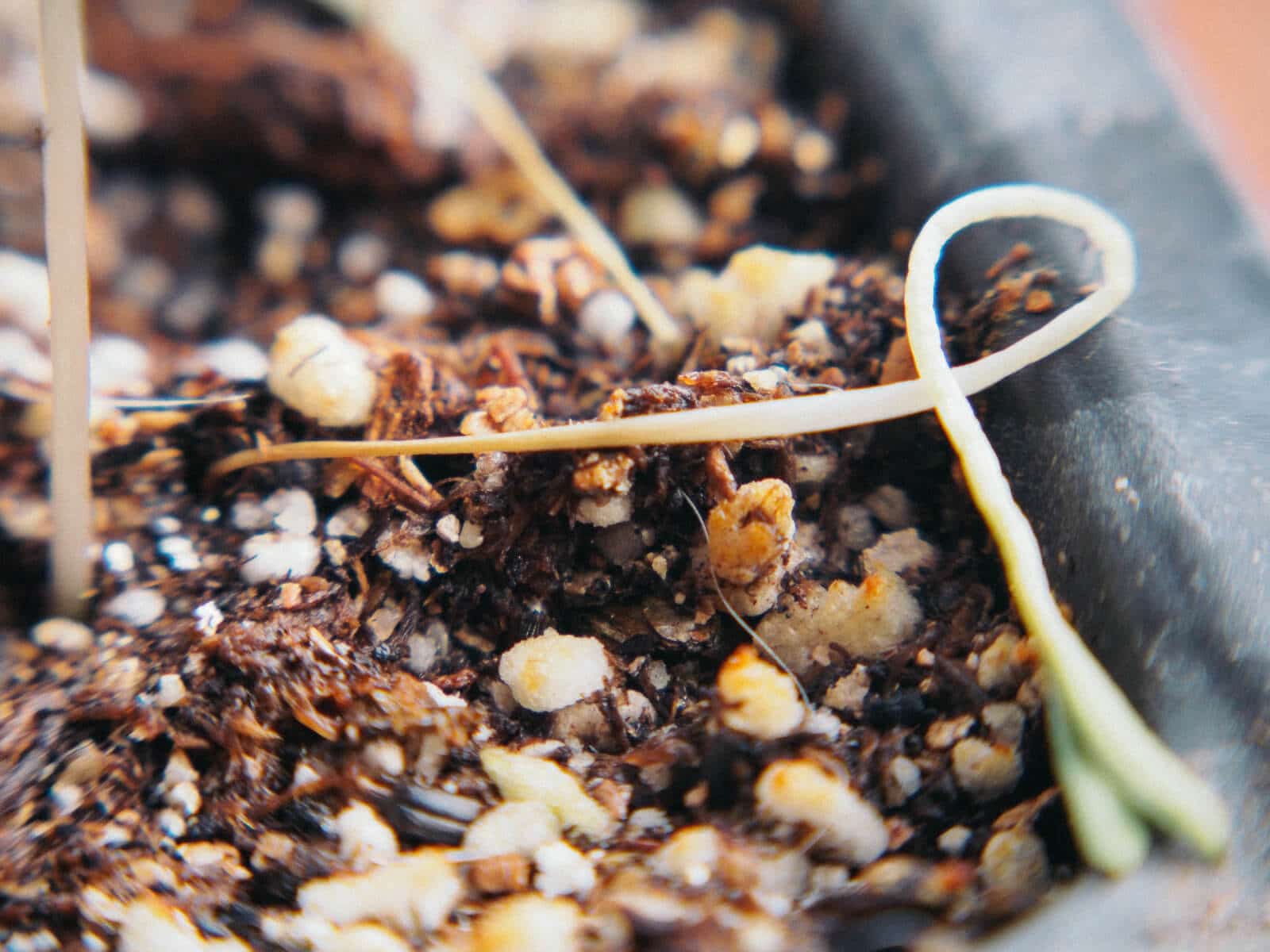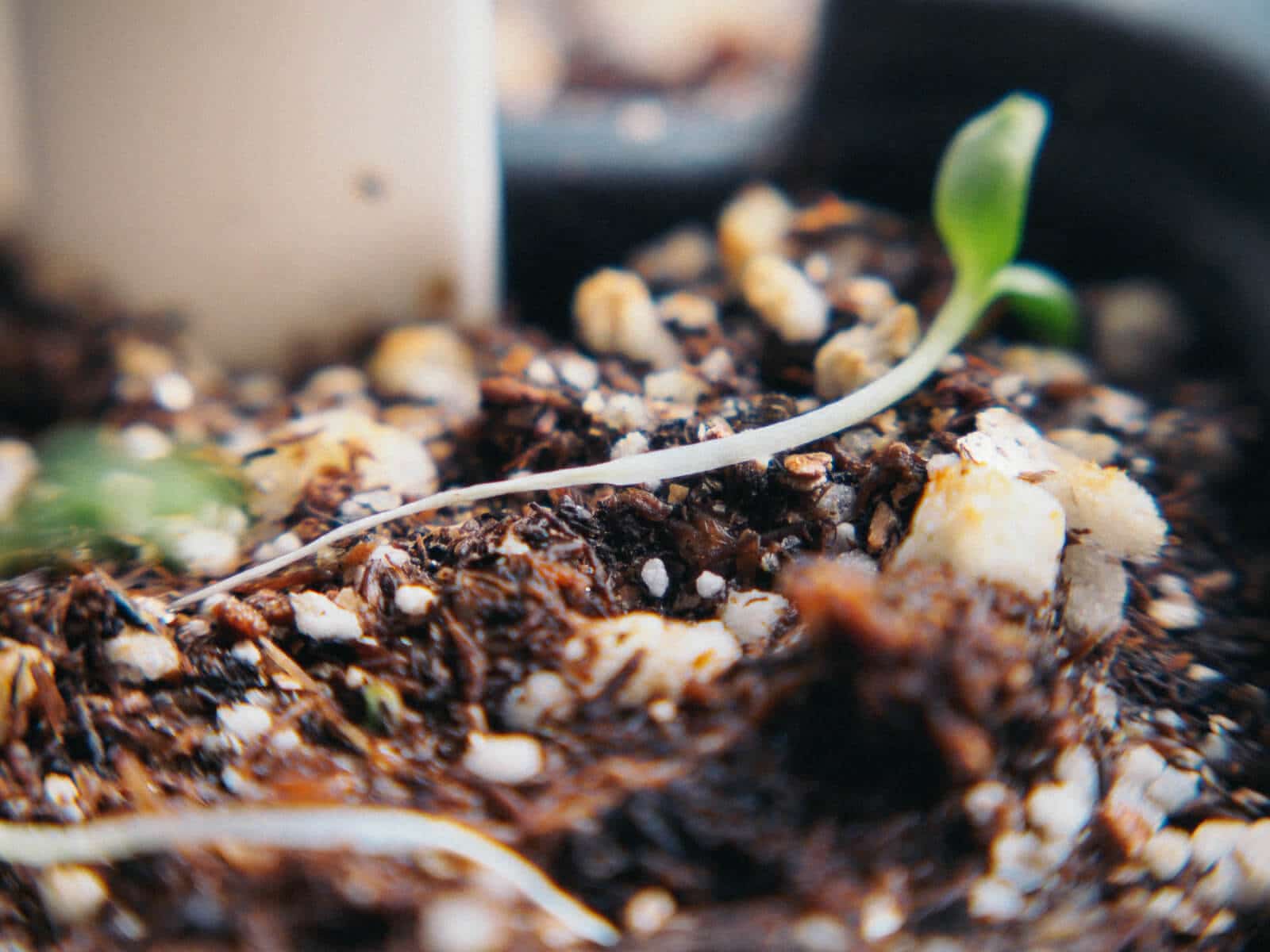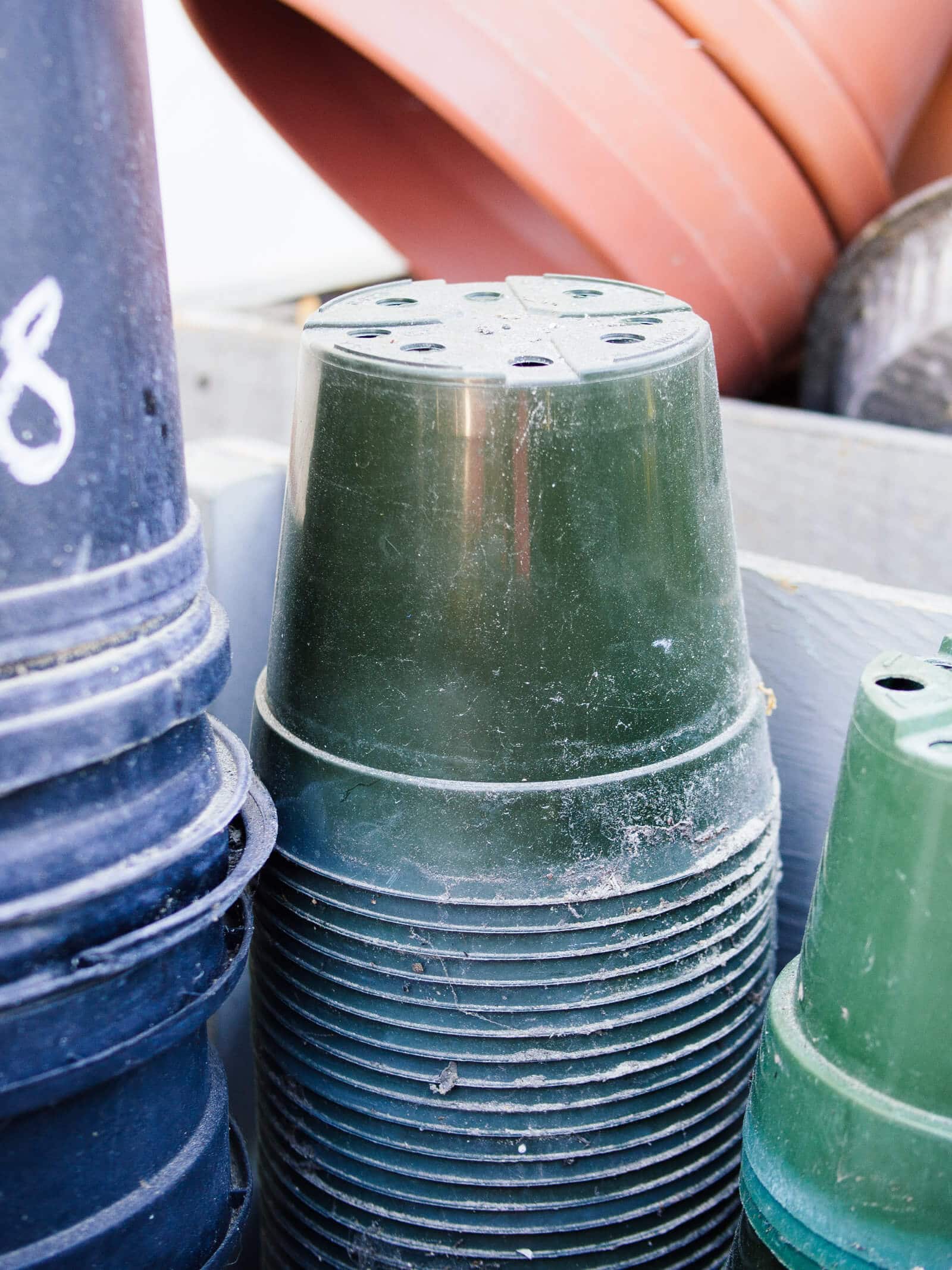It’s a sight that every seed starter dreads: a seemingly healthy seedling, perhaps even the first to sprout, suddenly slumped over the next day with a wizened stem.
You may have blamed old seeds or even lousy seed germination for a meager crop of seedlings, but more than likely, microscopic plant pathogens were at work below the surface.
Collectively, these pathogens cause a condition called damping off disease and while it’s not really treatable, it’s definitely preventable.

What causes damping off disease?
There’s never any warning when damping off might occur. The disease can take hold of a seed before it’s even sprouted, or a seedling before it’s formed its first true leaves.
Read more: This Is What Happens When a Seed Germinates
Caused by several species of seed-borne and soil-borne fungi including Pythium, Rhizoctonia, Fusarium, and Phytophthora, damping off disease can move through an entire tray of seedlings in a matter of days and once they’re infected, they’re near impossible to treat.
The plants that do survive the infection are often stunted and afflicted with “wire stem” symptoms: twisty, constricted stems that result in abnormal growth and smaller yields.
Damping off disease occurs in all types of seedlings, from tomatoes and peppers to leafy greens and root vegetables. One variety is not more susceptible than another, and disease-resistant strains will not prevent it from occurring.
While damping off can strike seeds and seedlings started outdoors, it most often affects indoor seedlings due to high humidity, poor ventilation, and overcrowded seed trays.

What does damping off look like?
Damping off is a fungal infection with easily identifiable symptoms: It’s characterized by the absence (or rotting) of roots; thin, thread-like stems where the seedlings are infected; and/or the presence of a white, gray, or pink cotton-like fungus at the base of the stem.
But, it can also wreak havoc in seeds below the soil in two different ways:
In pre-emergence damping off, fungi infect the seed as it germinates.
If the root is infected soon after it starts to grow, the shoot can rot underground before you ever see it. Damping off progresses swiftly and sometimes the seed decays before a stem even emerges.
This is probable cause for a complete lack of germination, or thin and patchy stands of seedlings where old or unviable seeds tend to take the blame.
In post-emergence damping off, fungi infect the stem near the soil surface.
The stem takes on a discolored, water-soaked appearance from the bottom up, weakens and withers and eventually collapses, unable to support itself. It often looks like someone—or something—just pinched it off.

How to treat damping off disease
Plant pathogens exist everywhere inside and outside, but they thrive under certain conditions that are typically found in poorly ventilated greenhouses or indoor seed starting environments.
If you suspect damping off in a seedling, be ruthless and remove it immediately. Once a seedling shows symptoms of damping off, this is the best way to control its spread to other plants.
As with most seed starting problems, it’s easier to stop damping off disease from happening in the first place, than try to fix it if it does. Once a stem shrivels at the base and the seedling is lying on the ground, it’s done. There is nothing you can do to save that seedling.
The good news is, damping off disease is easily preventable and you don’t need any chemicals to control it. The key is to give your seeds a clean, healthy start and keep moisture levels in check.

Disclosure: If you shop from my article or make a purchase through one of my links, I may receive commissions on some of the products I recommend.
How to prevent damping off
1. Don’t reuse dirty containers.
You don’t have to wash your pots if you didn’t have any problems with them last season, but it’s best to discard pots that previously held diseased plants or diseased soil.
To ensure healthy seedlings and minimize the chances of fungi spreading, start with fresh pots and plant markers, and tools that have been properly cleaned.
Related: DIY Tool Cleaning Station: The Fastest Way to Clean Garden Tools
2. Avoid using infected soil or heavy garden soil to start seeds.
When starting seeds indoors, always use new seed starting mix. It’s okay to reuse old seed starting mix for other tasks like repotting larger seedlings, but not for starting seeds. Make sure your seed starting mix is light and fast-draining (mixing in some perlite can help with drainage).
Resist the temptation to simply dump the soil from your yard into a pot to start your seeds. Garden soil is usually too heavy for seed starting pots and trays, and it often brings on other problems (like dormant weed seeds sprouting and competing with your seedlings).
3. Don’t sow seeds too deep.
Seed packets usually have instructions for sowing seeds, and it’s important to pay attention to seeds that need light or darkness to germinate.
As a general rule of thumb, seeds should be planted as deep as their size (measured by thickness or length).
For example, a pea seed should be planted about 1/4 to 1/2 inch deep, while a pumpkin seed should be planted about 1/2 to 1 inch deep.
For tiny seeds like basil, mustard, or carrots, sow your seeds on top of the soil, then add a layer of vermiculite or very fine granite (like chick grit) to cover. The drier, grittier surface is less likely to harbor fungi that cause disease.
4. Thin seedlings to avoid overcrowding.
Seedlings need proper airflow and plant spacing to not only strengthen their stems (which is part of the process of hardening off) but also to promote good root development and reduce the chances of disease.
After your seeds germinate and the seedlings grow their first true leaves, remember to thin the seedlings as needed to provide good air circulation around them.
5. Don’t overwater seedlings.
Seedlings don’t have very deep roots, so they do better with frequent but shallow watering where the roots are concentrated.
Because of this, it’s easy to water too much, especially if your indoor seed starting mix or outdoor garden soil is on the denser side.
Fungi thrive in wet conditions and overwatering gives them the perfect place to grow. So, try to keep the soil evenly moist but not waterlogged, and make sure the water drains freely out the bottom of your pots.
At the same time, don’t let the soil dry out between watering because peat-based soil mixes are very difficult to rewet once dry, leading you to water more than you have to.
6. Try not to get the leaves wet.
Do you constantly find moisture on your plants’ leaves after watering? It happens easily when you water with a spray bottle, squirt bottle, or watering can from overhead, even if you try to be careful.
Soil splash is a common cause of fungal disease in plants, especially with seedlings that don’t have the benefit of mulch to protect them.
To solve this problem, try watering your pots from the bottom up to avoid wetting the stems and leaves.
7. Monitor humidity levels and improve air flow.
Seedlings started in greenhouses with poor air circulation tend to suffer from damping off if humidity levels are too high.
The same goes for seedlings started under plastic humidity domes (which essentially act as mini greenhouses). These domes work well to trap heat and provide the warm environment that most seeds prefer for germination, but once they sprout, the domes should be removed either partially or completely.
In either situation, running a low-speed electric fan near young plants can gently circulate the air around them while strengthening their stems at the same time. (This “blowing” effect is similar to how you’d harden off seedlings with your hands.)
8. Avoid conditions that are too cool or too hot.
Seedlings need to be kept at the right temperature: too cool or too hot of an environment can weaken them. Also, Pythium is most active in wet, warm soils, while Rhizoctonia is more active in cool, moist soils.
When starting spring seeds, skip the heating mat (which only speeds germination time by a couple of days) and place your seedling trays in a non-drafty room with a comfortable room temperature.
When starting fall seeds, avoid starting them outside too early (that is, in mid-summer when air and soil temperatures are at their warmest) and start them indoors where they’ll germinate better in cooler conditions.
Read more: Find First and Last Frost Dates Accurately with This Custom Planting Calendar
9. Reduce other environmental stresses, like low light or excess fertilizer.
Damping off is sometimes exacerbated by environmental stress such as too little light (common when germinating seeds in a window in late winter to early spring, even if it’s a south-facing window), early pest damage, or excess nitrogen.
When seedlings are stressed, their immune defenses are down, leaving them susceptible to pathogens they otherwise might have been able to fight against.
Make sure you give your seedlings adequate light (which also prevents leggy seedlings), keep them away from other plants that have pest problems, and only use an organic fertilizer at half strength.

Treating damping off with cinnamon and other home remedies
Since the key to treating damping off is preventing the infection in the first place, it might make sense to preempt the problem by applying chamomile tea, clove tea, or a sprinkle of cinnamon to your soil.
After all, that’s what the Internet often tells you when you Google “how to treat damping off.”
All of these home remedies are known for their antifungal properties, but they’re 50/50 on whether or not they actually work.
Cinnamon, in particular, gets a lot of attention as a treatment for damping off and one thing is true: cinnamon has antifungal properties.
However, there are several different kinds of spices marketed commercially as cinnamon, and some of them may be effective against certain species of damping off fungi, but the one you have in your spice cabinet is probably not true cinnamon.
Many studies that show promising results on the use of cinnamon as an antifungal for damping off disease use concentrated alcohol extracts from the leaves. But, most people are sprinkling ground cinnamon bark on their soil (which is used to make the spice). Perhaps some active ingredient is extracted with water from wet soil, but the science on this isn’t clear.
Cinnamon does have plenty of anecdotal evidence to back up its use as a cure for damping off, and because of that, it’s worth a try (especially if you’re already following the strategies above for preventing the disease).
In the past I’ve sprinkled cinnamon on visible mycelium growth around my seedlings and the fungus seemed to die, so either the powder was effective enough to simply dry out the soil, or perhaps I got lucky and treated that particular fungus with the right kind of cinnamon.
This is something I’ll never know, and bottom line is, there’s no scientific proof that cinnamon works to stop damping off.

Should you sterilize your soil?
Various sources advise gardeners to sterilize their soil by baking it in an oven… literally spreading it out on a sheet pan and baking at low heat to rid the medium of microorganisms.
The reasoning?
When you start with a clean, blank slate, no nasty pathogens are threatening to claim your poor defenseless plants.
But by sterilizing your soil this way, you’re also removing the good microorganisms that plants depend on in the circle of life, rendering them even more defenseless. Without populations of good microbes to balance the bad, you’re inadvertently lessening your seedlings’ chances of survival in the real world.
“Living soils”—those inoculated with bacteria and fungi—simulate the environment your plant will eventually move into.
Rather than starting your seeds in a sterile potting medium, use a clean potting medium and drench it with compost tea as your seedling grows.
The compost tea will gradually build up microbial populations in the soil and strengthen the seedlings’ immune systems, in the same way that humans need bacteria to boost our own health.
Can you treat damping off with fungicides?
Truth is, most cases of damping off disease in plants result from overwatering and low ventilation.
Neither of these problems can be solved with fungicides.
Furthermore, fungicides only work if you apply the right one for the species of fungi you have. Unfortunately, it’s impossible for a gardener to ID the fungi that’s causing the problem, so the fungicide may or may not work in your case.
Rather than applying fungicides blindly, watch for signs of excess moisture or poor airflow as you start your seeds, and you’ll have a greater chance of raising strong, healthy seedlings.
This post updated from an article that originally appeared on March 10, 2015.
More help for seed starting problems:
- How Long Do Seeds Last? (+ Cheat Sheet on Seed Expiration Dates)
- This Is What Happens When a Seed Germinates
- Leggy Seedlings: What Causes Them and How to Fix Them
















Thank you for this information!! I am now using a small fan and have high hopes!!
Problem: gnats !!!!
??Question??: Do you have advice for getting rid of the gnats!!??
They are So frustrating!!
I have the sticky yellow – helps.
Fan – drys the top of soil.
Cinnamon – because I just read your article – don’t know if it is helping.
Help!!! 🙂
Thank you for the article. Last year I started Atlantic Dell Pumpkins inside in March, since I live in Roseau, MN which is Zone 2, I think. I got the seeds to germinate and they were thriving in their own recycled pop bottle green houses. I had first leaves about mid-April and we were looking great when they suddenly died. One by one, all seven just seemed to shrivel and die, and I wondered if they had run out of growing space, so I pulled the last one to find the roots looked rotted AND molded. I bet they each had dampened off– I tried to moderate watering and kept adding soil, but the soil source was from my nearby aloe plant… Now I know for this year. Thank You!!
RT @theGardenBetty: If your seedlings have suddenly keeled over… What is Damping Off Disease? #gardenchat #gardening http://t.co/XJ3hFwfu…
If your seedlings have suddenly keeled over… What is Damping Off Disease? #gardenchat #gardening http://t.co/XJ3hFwfuS3
What is Damping Off Disease? | Garden Betty http://t.co/uVYLETWiyE
Great post. Balance in things usually is the key, as well as a bit of attention. That is why I don’t cut down plants in the fall, they habour good organisms as well as bad. I can’t believe how many ladybugs hunker down for the winter in my marjoram patch – if I mowed it down they would not have what appears to be a comfy winter cabin.
Envious of your early gardening in CA. Still winter here in Alberta. A few seeds will get started indoors this weekend!
Cheers,
Jake
P.S. I made a couple batches of fresh pasta – a fresh thyme linguine, and whole wheat fettuccini…a relaxing Sunday afternoon, and a bit stashed in the freezer for a quick supper.
I let a lot of “weeds” populate my garden for that reason… they provide food and habitat for all those beneficial insects.
Making fresh pasta is a perfect Sunday activity! I love those long leisurely days in the kitchen. I always start mine with a glass of wine midday. 😉